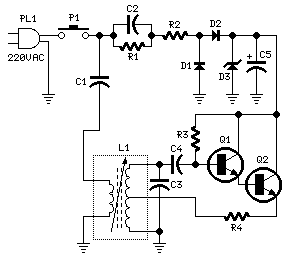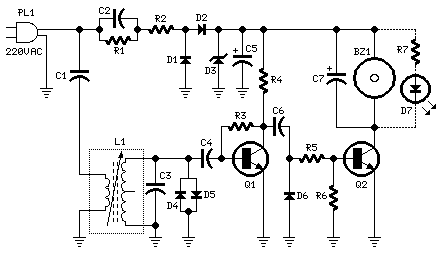Mains Remote-Alert
Remotely-operates a Beeper and/or a LED via mains supply line
Simple circuitry, easy to build unit
Transmitter circuit diagram:

Transmitter parts:
R1____________220K 1/4W Resistor R2____________470R 1/2W Resistor R3____________100K 1/4W Resistor R4______________1K 1/4W Resistor C1_____________10nF 400V Ceramic or Polyester Capacitor C2____________330nF 400V Polyester Capacitor C3______________1n5 63V Ceramic Capacitor (See Notes) C4_____________10nF 63V Ceramic or Polyester Capacitor C5____________100µF 25V Electrolytic Capacitor D1,D2________1N4007 1000V 1A Diodes D3_________BZX79C30 30V 500mW Zener Diode Q1,Q2_________BC546 65V 100mA NPN Transistors L1_______________IF Transformer for AM receivers, 445-470KHz P1_____________SPST Mains suited Pushbutton PL1____________Male Mains plug & cable
Receiver circuit diagram:

Receiver parts:
R1____________220K 1/4W Resistor R2____________470R 1/2W Resistor R3____________150K 1/4W Resistor R4______________2K2 1/4W Resistor R5____________100K 1/4W Resistor R6_____________47K 1/4W Resistor R7______________2K2 1/4W Resistor (Optional) C1____________100nF 400V Polyester Capacitor C2____________330nF 400V Polyester Capacitor C3______________1n5 63V Ceramic Capacitor (See Notes) C4,C6_________330pF 63V Ceramic Capacitors C5,C7_________100µF 25V Electrolytic Capacitors D1,D2________1N4007 1000V 1A Diodes D3_________BZX79C12 12V 500mW Zener Diode D4,D5,D6_____1N4148 75V 150mA Diodes D7_____________5mm. Red LED (Optional) Q1,Q2_________BC547 45V 100mA NPN Transistors L1_______________IF Transformer for AM receivers, 445-470KHz BZ1___________Piezo sounder (incorporating 3KHz oscillator) PL1____________Male Mains plug & cable
Device purpose:
Pressing the pushbutton of the transmitter, a sound and/or light alert is activated in the receiver. The system uses no wiring or radio frequencies: the transmitted signal is conveyed into the mains supply line. It can be used at home, in any room from attic to cellar, simply plugging transmitter and receiver in the wall mains sockets. Transmission range can be very good, provided both units are connected to the mains supply within the control of the same light-meter.
Transmitter circuit operation:
Q1 and Q2 are wired as a Darlington pair to obtain the highest possible
output from a Hartley type oscillator running at about 135KHz frequency. The
220Vac mains is reduced to 30Vdc without the use of a transformer by means of C1
reactance, a two diode rectifier cell D1 & D2 and Zener diode D3.
The
oscillator output is taken from L1 secondary winding and injected into the mains
wiring by means of C1.
Receiver circuit operation:
The 135KHz sinewave generated by the transmitter is picked-up from mains
wiring by C1 and selected by the tuned circuit L1-C3. Q1 greatly amplifies the
incoming sinewave and converts it in a 12V-peak squarewave. D4 & D5 limit
the input voltage at Q1 base to less than 1V-peak to avoid damaging of the
transistor due to the high voltage transients frequently occurring on the mains
line. D6 eliminates any negative component of the signal and Q2 drives the load.
C7 is necessary to smooth the signal residues appearing across the load.
The
12Vdc supply for this unit is obtained as described above for the transmitter
circuit.
Notes:
-
Transmitter and receiver coils L1s must be tuned regulating their ferrite cores to obtain maximum output at C3 leads, both in transmitter and receiver.
-
This setup is better done using an oscilloscope and placing the two units as far as possible to each other.
-
The tuning of the coils at 135KHz frequency should be obtained with the ferrite core almost totally inserted in its slot, if 455KHz IF transformers are used for both L1s.
-
Using IF transformers different from those specified, a change in both C3s value can be needed. The value of these capacitors may be varied from 1 to 3.3nF but must be the same in transmitter and receiver.
-
The load can be a beeper, a LED or both. Omitting the beeper and choosing the LED as the only load, its limiting resistor R7 should be reduced in value to about 1K, to increase device brightness. In this case, a 10mm. diameter LED type or greater, can also be useful .
-
Warning! These units are connected to 220Vac mains, then some parts in the circuit boards are subjected to lethal potential!. Avoid touching the circuits when plugged and enclose them in plastic boxes.






